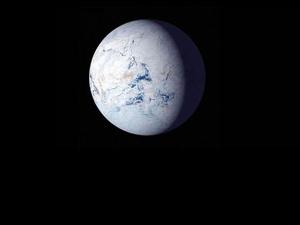
By James Gamble via SWNS
Scientists have uncovered why Earth was turned into a giant snowball in an Ice Age that lasted 57 million years – and warn that it could happen again.
Australian researchers believe the planet’s lowest-ever volcanic carbon emissions triggered the longest global ice age more than 700 million years ago.
The ice age transformed the Earth into a snowball ‘from poles to equator’ in a period before dinosaurs or even complex plant life existed.
Geologists used plate tectonic modeling to decipher what most likely caused the most extreme ice age in our planet’s history, called the Sturtian ice age.
The research team also warned that a similar ice age could be on its way, as the Earth is again on a similar trajectory of lower volcanic emissions.
The study, published in the journal Geology, helps us better understand the functioning of the built-in thermostat that prevents Earth from getting stuck in overheating mode and shows how sensitive global climate is to atmospheric carbon concentration.
The research team became inspired to investigate the subject by debris left by the ancient glaciation during the Sturtian ice age, which can still be observed in the Flinders Ranges of southern Australia.
The ice age was named after 19th-century colonial explorer of central Australia Charles Sturt and stretched from 717 to 660 million years ago.
A geological field trip to the Ranges, led by study co-author Professor Alan Collins, of the University of Adelaide, prompted the researchers to use the University of Sydney EarthByte computer models to investigate the cause and the exceptionally long duration of this ice age.
“Imagine the Earth almost completely frozen over,” the study’s lead author, Dr. Adriana Dutkiewicz, said.
“That’s just what happened about 700 million years ago; the planet was blanketed in ice from poles to the equator and temperatures plunged.
“However, just what caused this has been an open question.
“Various causes have been proposed for the trigger and the end of this extreme ice age, but the most mysterious aspect is why it lasted for 57 million years – a time span hard for us humans to imagine.”
The research team went back to a plate tectonic model that shows the evolution of continents and ocean basins at a time after the breakup of the ancient supercontinent Rodina.
They connected this to a computer model that calculates the CO2 degassing of underwater volcanoes along mid-ocean ridges – the sites where plates diverge and new ocean crust is born.
The researchers soon realized that the start of the Sturtian ice age correlates exactly with an all-time low in volcanic CO2 emissions.
They found the CO2 outflux also remained relatively low for the entire duration of the extreme ice age.
“We now think we have cracked the mystery,” Dr. Dutkiewicz explained.
“Historically low volcanic carbon dioxide emissions, aided by weathering of a large pile of volcanic rocks in what is now Canada; a process that absorbs atmospheric carbon dioxide.
“At this time, there were no multicellular animals or land plants on Earth.
“The greenhouse gas concentration of the atmosphere was almost entirely dictated by CO2 outgassing from volcanoes and by silicate rock weathering processes, which consume CO2.”
Study co-author Professor Dietmar Müller, of the University of Sydney, described the process as a ‘double-whammy’.
“Geology ruled climate at this time,” he said.
“We think the Sturtian ice age kicked in due to a double whammy: a plate tectonic reorganization brought volcanic degassing to a minimum, while simultaneously a continental volcanic province in Canada started eroding away, consuming atmospheric CO2.
“The result was that atmospheric CO2 fell to a level where glaciation kicks in – which we estimate to be below 200 parts per million, less than half today’s level.”
The researchers’ study raises intriguing questions about our planet’s long-term future.
A recent theory proposed that over the next 250 million years, Earth will evolve towards ‘Pangea Ultima’: a supercontinent so hot that mammals may become extinct.
However, the Earth is currently on a trajectory of lower volcanic CO2 emissions similar to those that spurred on the Sturtian ice age as continental collisions increase and the plates slow down, leading the researchers to suggest that, perhaps, Pangea Ultima will turn into a snowball once again.
“Whatever the future holds, it is important to note that geological climate change of the type studied here happens extremely slowly,” Dr. Dutkiewicz added.
“According to NASA, human-induced climate change is happening at a pace ten times faster than we have seen before.”



